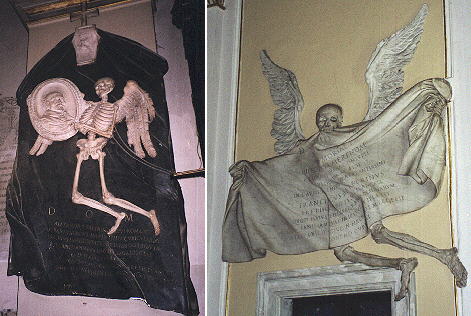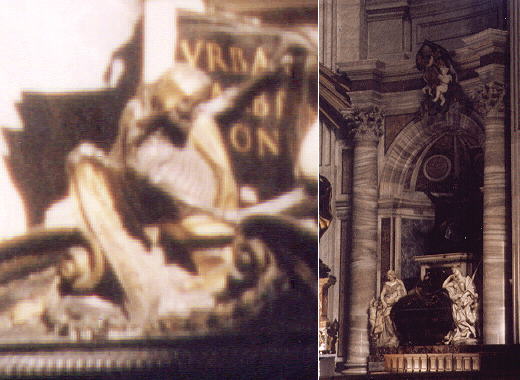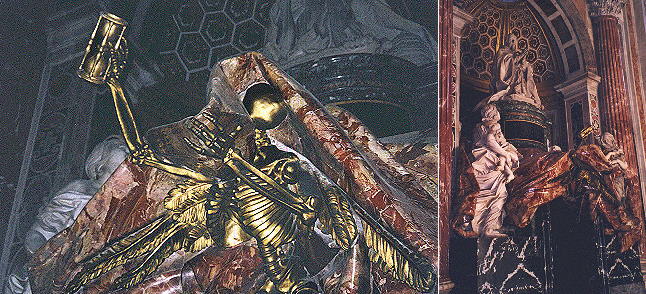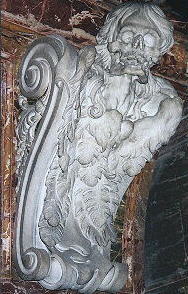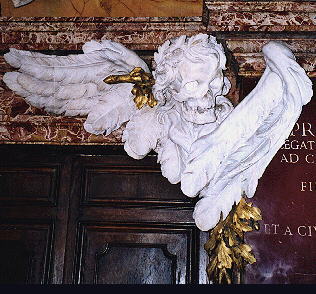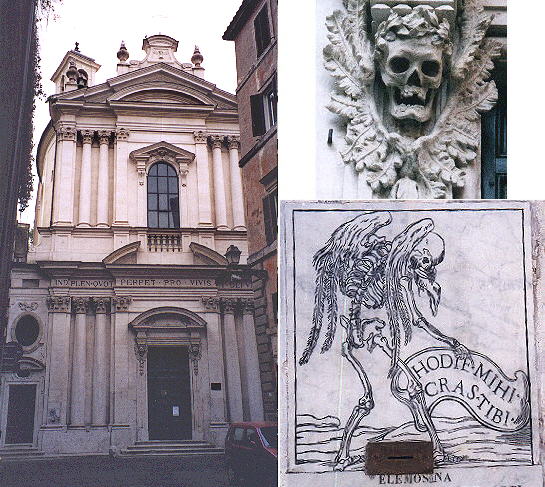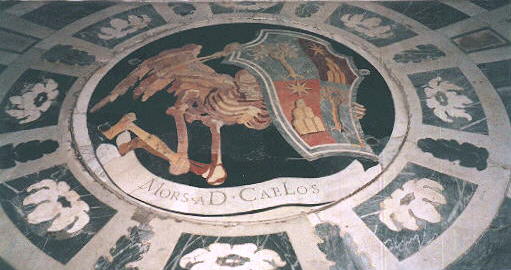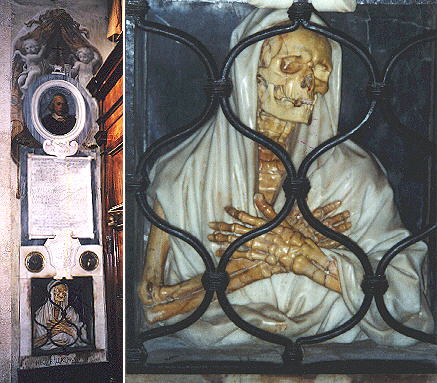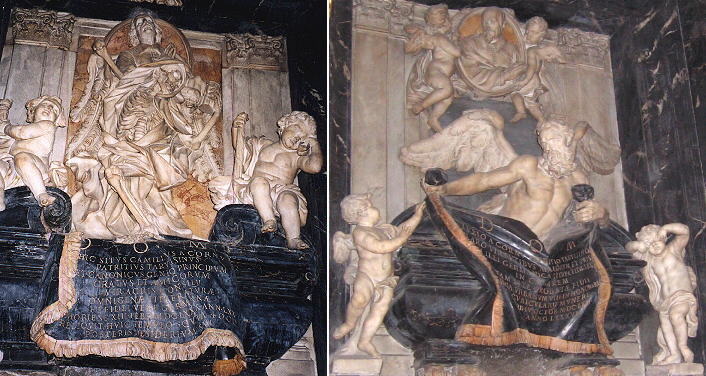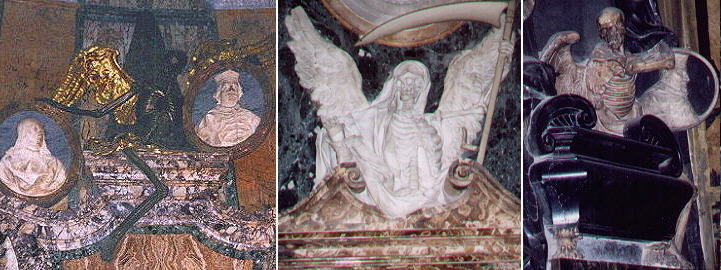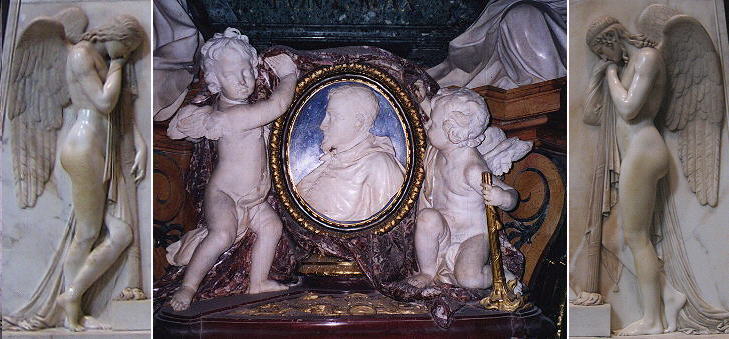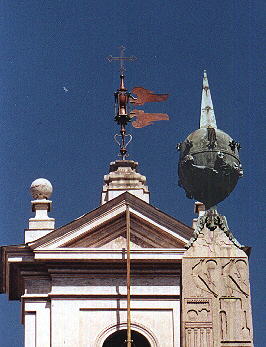  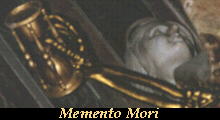 Memento Mori Memento Mori(Remember that you will die) This page deals with the representation of Death in sculptures in Rome
during the XVIIth and XVIIIth centuries. The request for sculptures was
mainly linked to funeral monuments. A visit to Galleria Doria Pamphily in Rome which is
still set up as a private property shows the lack of balance between the number of paintings and the
number of sculptures in the decoration of a rich palace: while the paintings covered the walls up to
the ceiling, the sculptures were limited to a few busts and antique statues, so sculptors had
to rely on funeral monuments for their living. Because the rich were buried in the churches,
they wanted a monument inside the church to mark their graves: the optimum was to have a family
chapel, but this was reserved to a limited number of very rich families, so very often the
monuments were just put along the walls or on the pillars of the churches.
Both tombs show a representation of Death in the form of a winged skeleton holding a portrait of the
dead or a celebratory inscription. Both monuments are not in chapels, but on the wall of the inner fašade.
The skeletons are not scaring and they are more the skeleton of the dead than a representation of Death.
A dramatic representation of Death also marks the Monument to Alexander VII again by Bernini (1678) in St Peter's. The Monument introduces several changes to the traditional papal monument: the pope is portrayed while he is praying on his knees and bare-headed and different materials are used to get a colorful effect: but the most striking thing is the arm of a skeleton holding a clepsydra (or hour-glass, a wasp-waisted reversible glass with two bulbs containing enough sand to take a definite time in passing from upper to lower bulb). Initially the viewer does not see the skeleton which is covered by a sort of drape.
The papal monuments which followed however were more similar to Bernini's Monument to Urbanus VIII than
to this monument. Only Antonio Canova more than a century later portrayed Clemens XIII in a similar
position and included a (very different) representation of Death. But there are skulls in the Monument
to Clemens X in St Peter's to remind the viewer of the vanity of life: in this case the skull wears a wig.
A very similar skull (wearing a laurel wreath) was designed by Paolo Posi in 1766 for the monument to a cardinal in S. Agostino.
The representation of Death reaches its peak in the church dell'Orazione e Morte near Palazzo Farnese. The church belonged to a confraternity having the objective to provide proper burials to the poor, especially in the countryside. The church was rebuilt in 1738 by Ferdinando Fuga and it is full of references to Death: skulls, clepsydrae, bones, inscriptions were all aimed at reminding the passer-by of what was awaiting him. The chapels built with bones and skulls in the church of the Capuchins near Piazza Barberini constitute another example of this "frank" relationship with death.
The skeleton in Cappella Chigi is holding the family coat of arms and the inscription includes a reference to the Holy Year 1650 (MDCL). Many people defined very clearly their funeral monument during their lifetime: an example is the very complex monument designed for himself by the painter Giovanni Battista Gisleni in S. Maria del Popolo.
The scholars of Bernini often dramatized to the extreme the representation of Death. Domenico Guidi in a monument in Chiesa di Ges¨ e Maria shows a skeleton which looks at the clepsydra as if it had an alarm bell and nearly overturns the portrait of the dead. Ercole Ferrata, in the same church, explores a different path: he shows Time in the act of ripping the name of the dead.
Representations of Death in funeral monuments continued to be very common until the second half of the XVIIIth century: sometimes they were a sort of light reminder in an otherwise sophisticated and elegant design, in other cases they were more pervasive as shown in the examples below.
Not everybody liked this representation of Death. The small monument to Cardinal Ludovisi inserted in the larger Monument to Gregorius XV by Pierre Legros in S. Ignazio, completed in 1717, shows a putto with a torch upside-down in a much more symbolic representation of Death. Antonio Canova in his Monument to Clemens XIII in St Peter's represented Death as a young man with a long torch upside-down. In his later Monument to the last Stuarts he sculpted two angels in a similar position and this approach to the representation of Death prevailed among neoclassicist artists.
The baroque passion for death symbols shows up also in the weathervane of Palazzo di Montecitorio, which today is the seat of the Italian Chamber of Deputies. I wish the Onorevoli (most honorable) Deputati who gather there, were aware of the meaning of this weathervane.
Have a look at Torture and Death in the churches of Rome.
Other pages dealing with Baroque sculpture: Statues in the act of praying Baroque Angels Monuments showing the dead in a medallion Three chapels by Gian Lorenzo Bernini Three busts by Alessandro Algardi Baroque Monuments to the Popes Baroque High Reliefs Statues Close to Heaven Embittered Andrew (the statues in St. Peter's octagon) Laughing Masks Playing with Colours See also my List of Baroque Architects and my Directory of Baroque Sculpture. Go to my Home
Page on Baroque Rome or to my Home Page on Rome
in the footsteps of an XVIIIth century traveller.
|
All images © 1999 - 2003 by Roberto Piperno. Write to romapip@quipo.it
